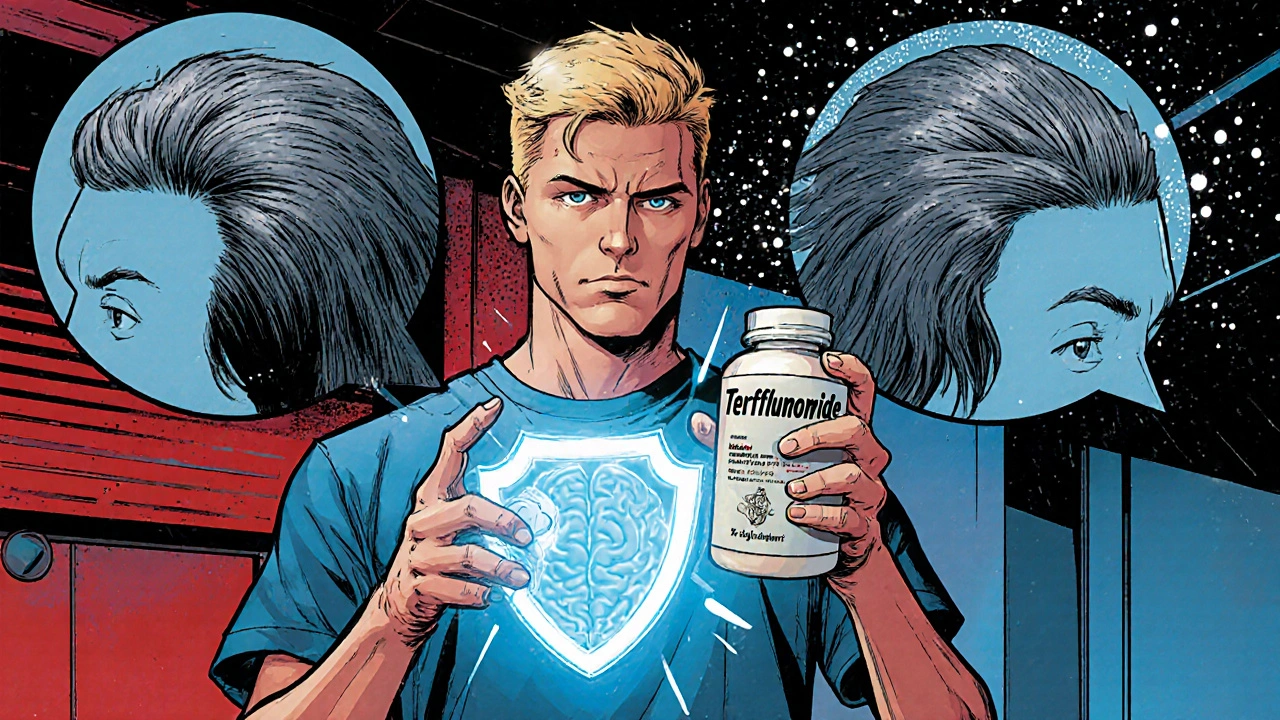Hair Loss Risk Calculator for Teriflunomide Users
Personal Risk Assessment
This tool estimates your risk of hair loss while taking Teriflunomide based on key factors discussed in the article. It's not a substitute for medical advice, but helps you understand what you can control.
Your Personal Risk Assessment
Recommended Actions
When you start Teriflunomide is a disease‑modifying therapy used to treat relapsing forms of multiple sclerosis. It’s sold under the brand name Aubagio and works by slowing down the immune system’s attack on nerve fibers. Many patients wonder why a drug that protects the brain can sometimes make the scalp feel like a desert. The short answer: the medication can interfere with hair‑growth cycles, leading to Hair loss (also known as alopecia) in a subset of users.
How Teriflunomide Works
Teriflunomide blocks the enzyme Dihydroorotate dehydrogenase, which is essential for the creation of pyrimidine nucleotides-building blocks of DNA. By limiting the proliferation of rapidly dividing immune cells, the drug reduces the frequency of MS relapses. This same anti‑proliferative effect can touch other fast‑growing cells, like those in hair follicles, especially during the anagen (growth) phase.
Why Hair Loss Happens
Hair follicles are among the quickest‑renewing parts of the body. When a drug tampers with DNA synthesis, follicles may prematurely enter the catagen (regression) phase and shed hairs. The phenomenon is called Telogen effluvium when it’s a diffuse thinning, and it’s the most common pattern linked to teriflunomide. The reaction isn’t an allergic rash; it’s a metabolic shift that the body can often reverse once the trigger eases.
How Common Is It?
Clinical trial data from the pivotal TEMSO and Teri‑STEP studies show that about 6‑10% of participants reported noticeable hair thinning. Real‑world registries suggest a slightly lower figure, around 4‑7%, because many people experience only mild shedding that goes unnoticed. The risk rises with higher plasma concentrations, which can happen if the liver isn’t clearing the drug efficiently.
| Side effect | Incidence (% of patients) |
|---|---|
| Hair loss (telogen effluvium) | 6-10 |
| Elevated liver enzymes | 5-8 |
| Diarrhea | 4-6 |
| Hypertension | 3-5 |
| Leukopenia | 1-3 |

What to Expect: Timeline
- Weeks 1‑4: Most patients notice the first signs of thinning, often as a gentle increase in shedding during washing.
- Weeks 5‑12: If the drug’s level remains high, shedding may peak. Some notice patchy thinning, especially around the crown.
- Months 4‑6: For many, the hair cycle stabilises. New growth begins, though the new strands may feel finer.
- Beyond 6 months: Persistent loss beyond this window should prompt a review with your neurologist or dermatologist.
Practical Ways to Reduce Hair Loss
While you can’t completely stop teriflunomide’s impact, several low‑risk strategies can help keep the hair pool healthier:
- Check liver function regularly. The drug is cleared by the liver; elevated enzymes often signal higher systemic exposure. Adjusting dose or adding cholestyramine (a drug that speeds up teriflunomide elimination) can lower levels.
- Maintain a balanced diet. Protein, iron, zinc, and omega‑3 fatty acids support keratin production. Foods like lean meat, beans, leafy greens, and fatty fish are excellent choices.
- Consider a biotin supplement. Biotin (vitaminB7) at 5mg per day has helped many patients improve hair thickness. Discuss dosage with your prescriber to avoid interference with lab tests.
- Gentle hair care. Avoid tight ponytails, harsh chemicals, and high‑heat styling. A mild sulfate‑free shampoo and occasional scalp massage can stimulate circulation.
- Stress management. Psychological stress can compound telogen effluvium. Mindfulness, short walks, or light yoga have shown measurable reductions in cortisol‑related hair shedding.
- Topical minoxidil. A 2% solution applied twice daily can prolong the anagen phase. It’s off‑label for drug‑induced loss but is widely used with good safety data.
When to Seek Medical Help
If you notice any of the following, book an appointment promptly:
- Hair loss exceeding 100hairs per day (roughly more than a half‑palm’s worth during washing).
- Patchy bald spots, especially if they don’t improve after three months.
- Accompanying symptoms like persistent fatigue, jaundice, or unusual bruising - signals that the drug may be affecting the liver or blood counts.
- Pregnancy or planning to become pregnant. Teriflunomide is teratogenic; rapid drug elimination protocols are mandatory.
Your neurologist may lower the dose, switch to an alternative disease‑modifying therapy, or use an accelerated elimination protocol (cholestyramine or activated charcoal). A dermatologist can run a scalp biopsy to differentiate drug‑induced telogen effluvium from other alopecia types.
Bottom Line
Hair loss on teriflunomide is uncomfortable but usually reversible. By monitoring blood work, nurturing nutrition, and using gentle hair‑care habits, most people keep the shedding to a minimum and see new growth within a few months. Keep an open line with your care team-early tweaks can save both strands and confidence.
Frequently Asked Questions
Can I stop teriflunomide if I lose hair?
Stopping the drug abruptly can increase the risk of MS relapses. Instead, discuss dose adjustment or an accelerated elimination plan with your neurologist.
How long does it take for hair to grow back?
Most patients see noticeable regrowth after 3‑4months once the drug level stabilises, but full thickness may take 6‑12months.
Is biotin safe with teriflunomide?
Biotin does not interact with teriflunomide, but high doses can interfere with lab assays, so inform your lab if you’re supplementing.
What lab tests should I have while on teriflunomide?
Baseline and quarterly liver function tests (ALT, AST), complete blood count, and serum teriflunomide concentration if you have persistent side effects.
Can topical minoxidil be used safely?
Yes, minoxidil works locally and does not affect systemic teriflunomide levels. Use as directed and report any scalp irritation.

CHIRAG AGARWAL
September 23, 2025
Teriflunomide does its job, but the hair fallout is a real buzzkill. You’ll probably see a few extra strands in the drain during the first month, then it usually settles down.
genevieve gaudet
October 5, 2025
It’s kinda wild how a drug that protects your nerves can mess with your scalp. The body’s trying to keep balance, I guess, and the fast‑growing hair follicles get caught in the crossfire. I’ve read that a protein‑rich diet can help, so loading up on eggs and beans might be a good move. Just remember, the hair will likely bounce back once the drug level eases.
Patricia Echegaray
October 17, 2025
What they don’t tell you is that the pharma giants love to hide the side‑effects behind glossy brochures. By throttling DNA synthesis, Teriflunomide isn’t just slowing immune cells, it’s also throttling the hair rebellion. Some folks even whisper that the “telogen effluvium” label is a smokescreen to keep patients quiet. Keep an eye on your liver labs, because a bully dosage can turn a minor shed into a full‑on bald patch. Trust but verify, and maybe ask for a serum level check before you sign up for the full course.